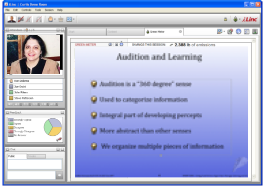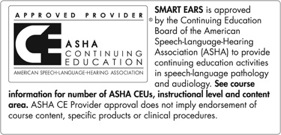Online Workshop Series
Teaching Children with Hearing Loss
to Listen and Talk
Activities In-Depth
- This workshop follows up on the "Auditory Activities" workshop by taking it to the next level, by drilling down into the actual mechanics of an auditory activity, spending time on the nitty-gritty.
- We will focus on an activity for developing each of the following auditory skill types: Auditory Feedback, Auditory Comprehension, Auditory Discrimination/Memory, and Expressive Communication.
- Learn to create the need for verbal communication and cognitive engagement during an activity.
- Learn to script the language for your activity using a template, down to the last detail.
- Learn to vary your strategies during the activity to stretch the child's auditory skills.
- Earn ASHA CEUs (and LSLS hours)!
AT A GLANCE
Title |
Teaching Children with Hearing Loss to Listen and Talk - ACTIVITIES IN-DEPTH |
Level |
Presenter |
Pratibha Srinivasan, Au.D., CCC-A, LSLS-Cert.AVT |
When |
11 AM - 4:00 PM Eastern Time Date: Not currently scheduled |
Intended Audience |
Teachers of the Deaf, Speech-Language Pathologists, Audiologists, Special Educators & other professionals who work with children with hearing loss. |
CEUs |
 This course is offered for 0.4 ASHA CEUs (Intermediate Level, Professional Area) ------------------------------------  This workshop provides 4.0 hours of LSLS CE/Learning credit. ----------------------------------- For other professionals, this course should provide 4 professional development hours. See FAQ below for more information |
Equipment Required |
PC or Mac, USB Headset; or iPad or other tablet; See FAQ for more details. |
Registration |
$119 per participant Click Here to Register Now! |
Time (EST) |
Topic |
||||
|---|---|---|---|---|---|
11:00 TO 12:00 |
Overview Auditory Feedback a) Levels of auditory feedback practice b) Using a template to structure the activity c) Varying the difficulty level d) Example |
||||
12:10 TO 1:10 |
Auditory Comprehension a) Scripting the language for comprehension b) Providing repetition during auditory immersion activities c) Varying difficulty and integrating cognitive tasks d) Example |
||||
1:10 TO 1:50 |
LUNCH BREAK |
||||
1:50 TO 2:50 |
Auditory Discrimination and Memory a) Scripting the language for discrimination b) Connecting the language with feedback and comprehension c) Getting to open set during the activity d) Example |
||||
3:00 TO 4:00 |
Developing Expressive Communication a) Integrating the communicative 'need' into the activity b)Activities to target specific language c) Scripting the acceptable responses for phonetic, word and sentence levels d) Example |
||||





